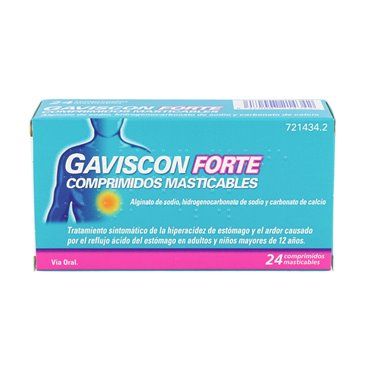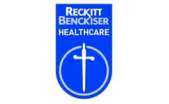Gaviscon Forte 24 Chewable Tablets
Gaviscon Forte Chewable Tablets is indicated for the treatment of hyperacidity of the stomach and heartburn caused by acid reflux of the stomach in adults and children over 12 years of age.
Gaviscon Forte Chewable Tablets is indicated for the treatment of hyperacidity of the stomach and heartburn caused by acid reflux of the stomach in adults and children over 12 years of age.
Gaviscon Forte (24 Chewable Tablets)
INDICATIONS
- Symptomatic treatment of [GASTRIC HYPERACITY] and burning caused by acid reflux in the stomach.
POSOLOGY
- Adults and over 12 years (normal and strong), oral: 2-4 chewable tablets or 1-2 sachets, as needed, up to 4 times a day; maximum 16 tablets / day or 8 sachets / day.
- Children <12 years: not recommended, except for better medical judgment.
As with all antacids, if symptoms persist for more than 7 days despite continuous treatment, the clinical situation should be evaluated.
RULES FOR THE CORRECT ADMINISTRATION
- Oral administration, preferably after meals and before going to bed.
- It should not be taken with large amounts of milk or dairy products since (due to its content of calcium antacids) it can cause increased levels of calcium in the blood and milk and alkaline syndrome (Burnett syndrome).
- Distance the administration of this medication and any other drug.
CONTRAINDICATIONS
- Hypersensitivity to any component of the drug.
- Severe renal failure (CLcr <30 ml / min).
- [HYPERCALCEMIA] or conditions that cause hypercalcemia
- Background of [HYPOPHOSPHATEMIA]
- Nephrolithiasis due to [KIDNEY STONES] of calcium.
PRECAUTIONS
- [RENAL CALCULATIONS]. Avoid prolonged use because it increases the risk of developing kidney stones.
- [HYPERCALCEMIA]. The administration of high doses for long periods of time can produce undesirable effects such as hypercalcemia and alkaline milk syndrome, especially in patients with kidney failure. The drug should not be administered with large amounts of milk or lactic products.
- [HYPERCALCIURIA]. It should not be administered in these patients.
- [RENAL INSUFFICIENCY]. Administration is not recommended in patients with severe renal impairment (CrCr <30 ml / min). If administered prolonged at CrCr> / = 30 ml / min, plasma calcium, phosphate and magnesium levels should be regularly monitored.
- In general, antacids containing calcium should not be administered to patients with [CONSTIPATION], [HEMORRHOIDS] and [SARCOIDOSIS], except in the best medical judgment.
- Patients with very low levels of gastric acid. There is a possibility of reduced efficacy in these patients.
- Isolated cases of a possible relationship between calcium carbonate, [APPENDICITIS], [GASTROINTESTINAL HEMORRHAGE], [INTESTINAL OBSTRUCTION], or [EDEMA] have been described in the literature.
PRECAUTIONS RELATED TO EXCIPIENTS
- This medicine contains aspartame as an excipient, so it should be taken into account by people affected by [PHENYLKETONURIA]. 100 mg of aspartame corresponds to 56.13 mg of phenylalanine.
- This medicine contains sodium salts. To know the exact content of sodium, it is recommended to check the composition. Oral and parenteral dosage forms with sodium amounts greater than 1 mmol (23 mg) / maximum daily dose should be used with caution in patients with [RENAL INSUFFICIENCY] or diets low in sodium.
INTERACTIONS
- Digitalis (digoxin, digitoxin): there are studies with some antacids (algeldrate, magnesium hydroxide) in which there has been a decrease in the absorption of digitalis, so it is recommended to space its administration 2 or 3 hours.
- Erlotinib: possible reduction of erlotinib levels, by reducing its absorption. Antacids increase gastric pH, which could decrease erlotinib's solubility, absorption, and therapeutic effects. It is recommended to administer at least 4 h before or 2 h after the daily dose of the antineoplastic.
- Gabapentin: a certain decrease in gabapentin levels has been observed when administered together or in the 2 h after taking other antacids, due to an increase in pH. It is recommended to administer gabapentin 2 hours before an antacid.
- Quinolones (ciprofloxacin, norfloxacin): there are studies with some antacids (algeldrate, almagate) in which there has been a decrease in their absorption due to the formation of non-absorbable insoluble complexes at the intestinal level, so it is recommended to separate their administration 2 or 3 h.
- Iron salts (citrate, fumarate, iron sulfate): there are studies with some antacids (algeldrate, magnesium trisilicate) in which there has been a decrease in absorption due to the formation of poorly soluble complexes, so it is recommended to space the administration 2 or 3 h.
- Lithium salts (lithium carbonate): there are studies in which a possible increase in their renal excretion has been registered with loss of antimanic activity, because part of the sodium can be reabsorbed instead of lithium.
- Tetracyclines (tetracycline): there are studies in which possible formation of non-absorbable complexes has been recorded at the gastrointestinal level, thus reducing their absorption, so it is recommended to space the administration 2 or 3 hours.
PREGNANCY
An open-label, controlled study of 281 pregnant women showed no significant adverse effect of Gaviscon on the course of pregnancy or on the health of the unborn child / fetus. Based on this and previous experience, this medicine can be used during pregnancy. In any case, taking into account the presence of calcium carbonate, it is recommended to limit the duration of treatment as much as possible and avoid the concomitant intake of milk and milk products to prevent excess calcium that can trigger a milk-alkaline syndrome.
LACTATION
Accepted use. Its chronic or excessive use is not recommended.
ADVERSE REACTIONS
- Exceptionally, allergic reactions such as [URTICARIA] or [BRONCHIAL SPASM] and [ANAPHILAXIA] have been observed.
- It has also been reported that metabolic and nutritional disorders such as [HYPERCALCEMIA] and [ALKALOSIS] as well as Burnett syndrome (milk-alkaline syndrome) may occur due to prolonged and high-dose use.



